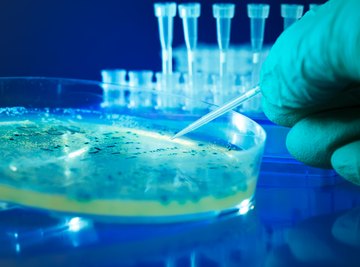
Biologists and biology students employ a variety of instruments in their work to collect knowledge about living things. These instruments and tools become more elaborate and high-tech every year, as do the ways in which biologists make use of them. Imagine explaining the concept of a GPS animal-tracking collar or microchip to a scientist from only 100 years ago.
The tools of the biology trade are almost limitless, but most students are familiar with a fair number of the common ones in the lab and in everyday research and observation use.
Basic Stockroom Tools
Most high-school students graduate with some familiarity with the basic tools used in biology lab experiments, including:
- Beakers, which are cylindrical containers
- Flasks, which are tapered beakers and used to hold liquids that will be warmed
- Bunsen burner, hot plate or another heat source
- Slides, upon which living or once-living matter is placed for inspection under a microscope
- Graduated cylinders into which specifically measured amounts of fluid are placed. "Graduated" refers to measurement marks on the side of the cylinder in milliliters or cubic centimeters.
- Pipettes used to stir preparations of liquids.
Many of these same tools are used in chemistry experiments as well. One of the critical aspects of biology is that it overlaps with so many other major scientific disciplines.
Microscopes
Without microscopes, biology would be stuck in the same place astronomy without telescopes.
Instruments resembling microscopes have existed since at least the 1590s, although Robert Hooke and Anton von Leeuwenhoek are often credited with inventing the first "real" microscopes in the 1600s using carefully ground lenses. Over the years, increasingly powerful microscopes have allowed biologists to peer a great depth into the elemental constituents of life: tissues, cells, organelles and atoms. Decades ago, scanning and transmission electron microscopes revolutionized microbiology and are now standard fare in most university biology departments.
Cell Cultures
Scientists have known for decades that bacterial and yeast cells can be grown in nutrient-rich media—a culture. More recently, researchers have had success doing the same thing with a variety of plant and animal cells of increasing complexity. Whereas primitive culture media contained little more than salts and glucose, those used for animal-cell cultures include various amino acids, vitamins and serum. The latter provide growth factors that promote the complex cell differentiation required for specialized animal-cell cultures to thrive but are not needed for bacteria or yeast to grow.
Computers and Imaging Systems
With the age of DNA sequencing well underway, it is important to be able to look up genetic information in real time in a countless range of biology experiments. To this end, image-analysis software (from Typhoon, Storm or LAS500, for example) and DNA, RNA and protein sequence-analysis programs have become components of many biology laboratories around the world.
References
About the Author
Kevin Beck holds a bachelor's degree in physics with minors in math and chemistry from the University of Vermont. Formerly with ScienceBlogs.com and the editor of "Run Strong," he has written for Runner's World, Men's Fitness, Competitor, and a variety of other publications. More about Kevin and links to his professional work can be found at www.kemibe.com.
